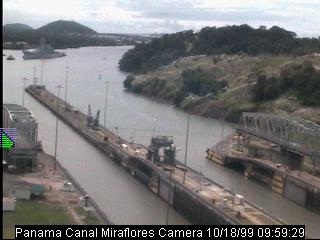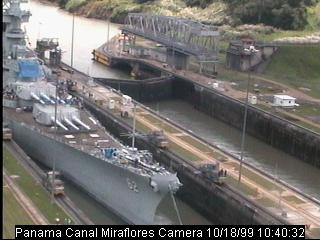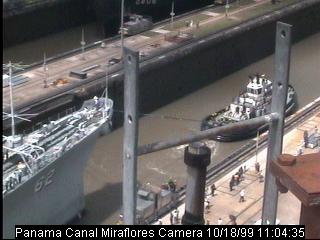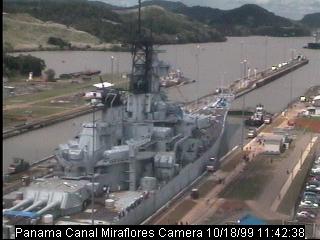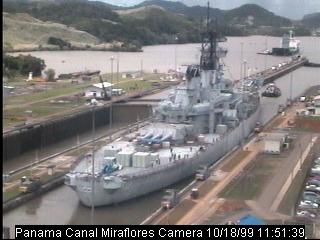|
Launched December 7, 1942 from the Philadelphia Naval Shipyard, the New Jersey was commissioned on May 23, 1943. She made her first Panama Canal transit January 7, 1944, while enroute to the Pacific ocean to join the US Navy's pacific fleet. Her 108 foot beam was designed to barely fit in the lock chambers. She had less than a foot of clearance on each side, and her dimensions were tested for the first time that Friday morning. Fortunately, she transited the locks without trouble.
After serving proudly during World War II, where she saw action in the Marshall Islands, as well as Iwo Jima and Okinawa, New Jersey was decommissioned on June 30, 1948. She entered the reserve fleet at Bayonne, NJ, , where she remained mothballed for two and one half years. In the wake of the North Korean attack against South Korea in June 1950, the US Navy ordered New Jersey to be readied for additional service. On Sept 29, 1950, workers began the task of removing covers, checking the hull, and assembling a fresh crew. Recommissioned November 21, 1950, she spent several months at the Brooklyn Naval shipyard where she received additional repairs and updated equipment. In April, 1951 she steamed toward the Pacific ocean, transiting the Panama Canal April 20th.
At the conclusion of the Korean War, New Jersey began a series of world deployments. On November 9, 1953, she once again sailed towards the Panama Canal for a northbound transit. While entering Miraflores Locks, she suffered an embarrassing mishap - she ran aground. It had been a very dry year in Panama, and canal employees were trying to conserve water when filling the lock chambers. The bottom "corners" of the chambers are rounded, not squared. The pilot had allowed enough water to flow under the keel - barely. The bow made it into the chamber, but bilge keel (which run along the most lower part of the hull on each side) got hug up on the rounded corners of the chamber. Additional water had to be let into the chamber, raising the ship a foot or two so she could float free.
The US Navy has no sense of humor when it comes to running one of its ships, especially a capital ship, aground. In just about any other situation, the grounding of a naval vessel, even if it occurs while under the control of a pilot, earns her captain a very early retirement. But the Panama Canal is different - the captain must not only turn control of his vessel over to the pilot, he must relinquish command as well. So, as additional water began to flow under the keel, the skipper of the USS New Jersey ordered some coffee, lit up a cigar, and waited for the ax to fall some place else.
|
